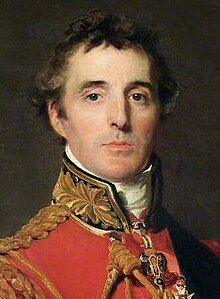Lines of Torres Vedras
Bailén - Roliça - Vimeiro - Saragossa (1808) - Burgos (Gamonal) - Medina de Rioseco - Espinosa - Tudela - Somosierra - Saragossa (1809) - La Coruña - Torres Vedras - Valls - Braga - Oporto - Talavera - Ocaña - Gerona - Ciudad Rodrigo (1810) - Buçaco - Gévora - Barrosa - Badajoz (1811) - Fuentes de Oñoro - La Albuera - Tarragona (1811) - Sagunto (Murviedro) - Ciudad Rodrigo (1812) - Badajoz (1812) - Majadahonda - Salamanca - García Hernández - Venta del Pozo - Vitoria - Sorauren - San Sebastián - Bidassoa
The lines of Torres Vedras ( Portuguese also for short Linhas de Torres ) were a triple line of fortifications made up of forts, trenches and natural ridges around the capital of Portugal . In 1810 they served the British-Portuguese defense against the Napoleonic invasions .
history
prehistory
To enforce its 1806 decreed Continental System to see Napoleon forced in view of holding Portugal to its centuries-old alliance with the United Kingdom , the Kingdom of Portugal to occupy. The Portuguese court fled the massive Napoleonic threat to its colony in Rio de Janeiro in 1808, leaving only an emergency government of five in Lisbon. The historically unique case occurred that with Brazil, a colony was the capital of a colonial empire, and the mother country Portugal was considered a colony of Brazil for the following 14 years. In this way, the royal family ensured the independence of Portugal. In view of this unchanged alliance between Britain and Portugal, which kept its ports open to its English ally, Napoleon decided, after two previous campaigns, to tackle the conquest of Portugal again. He sent Marshal Masséna with an army to Portugal, whereupon the British General Arthur Wellesley , who later became Duke of Wellington, landed with an army in Portugal in August 1808, in Lavos near Figueira da Foz . The French troops were very unpopular with the population due to the deaths and the destruction caused, and a broad popular resistance formed against them, which greatly favored the British-Portuguese defense.
course
The advance of the superior forces of Massénas seemed at first unstoppable. Wellington then developed the concept of the Torres Vedras Lines, so named after the outermost of the three defensive lines designed around the capital. Lisbon continued to be the strategically crucial place in Portugal, although the royal family was already out of the country in Rio de Janeiro.
Wellington gave the lines to the British engineer Richard Fletcher (1768-1813) on October 20, 1809 , under whose direction they were built by Portuguese military units and workers. Wellington was inspired to build the fortress by the buildings of the Portuguese army engineer José Maria das Neves Costa (1774–1841).
A fortress of around 1,300 square kilometers was created, protected by the Atlantic Ocean to the west, the Torres Vedras lines to the north, and the Tagus River to the east and south . It was the largest fortification of all time. In the southeast corner of this fortress was the Portuguese capital to be protected. On September 27, 1810, at the Battle of Buçaco, Masséna's advance received a serious setback for the first time, but the Marshal continued to strive relentlessly towards the capital Lisbon .
The now established lines of Torres Vedras formed a retreat for the British-Portuguese army and were supposed to stop the advance of Marshal Masséna for good. The originally 65,000 strong army of Masséna arrived at the lines with a remaining strength of about 36,000 men, emaciated by the long march and lack of food, and discouraged by the unexpectedly found, impassable fortress lines. This stopped the Masséna's troops for over five months, during which the French marshal waited in vain for reinforcements. After an unsuccessful attempt at Sobral de Monte Agraço on October 14, he did not dare to attack the positions again. At the beginning of May 1811, the attackers withdrew discouraged and were finally pushed beyond the Portuguese borders by the pursuing Wellington in October 1811.
effect
In order to achieve maximum effect, a scorched earth strategy mandated by the government of Portugal was implemented while retreating behind the Torres Vedras lines . The French army received supplies from the country, so that it was badly hit. Still, their commanders thought that Wellington would either accept a battle in which they hoped to defeat him or withdraw from Portugal.
Wellington, however, had the massive fortification work carried out in complete secrecy; not even his own government knew of their construction. This took the French by surprise. They had only expected a few small forts and not such gigantic fortifications that made an attack hopeless. The hill slopes were artificially steeper and reinforced with fortifications at the top. The valleys had also been flooded and secured by massive barricades and thorn bushes piled up in front of them. In addition, dozens of batteries with heavy ship guns were set up in strategically important positions so that enemies could be shot at from the flank. A separate road system had been laid behind the lines so that troops could move quickly along the lines.
Faced with these fortifications, the advance of the French army was forced to stop. Apart from an unsuccessful attack attempt and some skirmish , the French troops left the lines without a battle.
The French army, which is unpopular in the country, was often subjected to attacks by guerrilla groups and by British and Portuguese cavalry , and hunger was also increasingly threatening. Napoleon's soldiers were already on the march to the Torres Vedras lines through plundered and cleared land. On the way back, feeding them became an even more hopeless task. The French invasion forces therefore had less and less to oppose the attacks of the British-Portuguese troops pursuing them, who had undisturbed supply routes, despite their numerical superiority. The third attempt by Napoleon to permanently conquer Portugal ended unsuccessfully.
Key figures
The Torres Vedras lines stretched at the height of Torres Vedras from the Portuguese Atlantic coast to the Tagus River and were about 40 kilometers long. They consisted of 152 fortifications and 600 pieces of artillery.
Construction began in October 1809 and was largely completed when Wellington withdrew after the Battle of Buçaco on September 27, 1810.
According to British sources, the Torres Vedras lines were held by a total of 25,000 Portuguese, 8,000 Spanish, and 2,500 British soldiers. The regular army that Wellington had pulled behind the lines and pulled together was 60,000 strong and comprised of Portuguese and British. There were also militias outside the regular army. Portuguese sources name 36,000 Portuguese, 35,000 British, and 8,000 Spanish regular soldiers who stood behind the lines, which were joined by irregular Portuguese units with a total of 60,000 men.
The lines today
After the "attack" the lines were never used again. 129 of the buildings that have been preserved are already listed and are now an attraction for visitors. Thematic hiking trails and visitor centers have been set up within this framework. Thematic rallies and equestrian events also take place along the lines today.
filming
After her husband Raúl Ruiz passed away in 2011, the Chilean director Valeria Sarmiento continued his film project to look at what happened on the lines in many different ways. This resulted in the 2012 movie Lines of Wellington - Storm over Portugal and the following TV multi-part series Linhas de Torres Vedras , u. a. with John Malkovich , Soraia Chaves , Mathieu Amalric , Catherine Deneuve and Nuno Lopes .
literature
- AH Norris, RW Bremner: The Lines of Torres Vedras ., The British Historical Society of Portugal 1980.
- Jac Weller: Wellington in the Peninsula. 1808-1814. Nicholas Vane, London 1962 (reprinted. Kaye, Ward, London, 1969).
- Sir Charles Oman: A History of the Peninsular War, Volume III ., Greenhill Books 1996. ( ISBN 1853672238 )
- André Melícias: As Linhas de Torres Vedras. , Livrododia 2008. ( ISBN 9789728979232 )
- Climaco: As Linhas de Torres Vedras . Edições Colibri 2010. ( ISBN 9789896890292 )
- Carlos Guardado Silva: As Linhas de Torres Vedras . Edições Colibri 2010. ( ISBN 9789727729975 )
Web links
- Official website for the 200th anniversary of the Torres Vedras (port.) Lines
- Website on the history of the lines of Torres Vedras (port.)
- Website of a school project on the lines of Torres Vedras (port.)
- Blog on the lines of Torres Vedras (port.)
- Lines of Torres Vedras, Historical Trail (Engl.)
Individual evidence
- ↑ António Henrique de Oliveira Marques : History of Portugal and the Portuguese Empire (= Kröner's pocket edition . Volume 385). Translated from the Portuguese by Michael von Killisch-Horn. Kröner, Stuttgart 2001, ISBN 3-520-38501-5 , p. 329ff.
- ↑ History of the Torres Vedras lines on the Torres Vedras district administration website (port.), Accessed on November 3, 2013
- ↑ www.peninsularwar.org , accessed November 3, 2013
- ^ António Henrique de Oliveira Marques: History of Portugal and the Portuguese Empire. Kröner, Stuttgart 2001, ISBN 3-520-38501-5 , p. 332.
- ↑ History of the Torres Vedras Lineage at www.peninsularwar.org, accessed November 3, 2013
- ^ Eyewitness report in: Ruthard von Frankenberg: In the Black Corps to Waterloo. Memoirs of Major Erdmann von Frankenberg . edition von frankenberg, Hamburg 2015. pp. 68–73
- ^ Page on the Lines of Torres Vedras on the history page www.peninsularwar.org, accessed on November 3, 2013
- ↑ History page on the thematic website of the Torres Vedras district administration (port.), Accessed on November 3, 2013
- ↑ www.monumentos.pt (list appears after entering the search term Linhas de Torres Vedras ), accessed on November 3, 2013
- ↑ Official thematic website of the district administration of Torres Vedras (port.), Accessed on November 3, 2013
- ↑ Page of the Raid Hípico das Linhas de Torres Vedras horse show ( Memento of the original from April 18, 2016 in the Internet Archive ) Info: The archive link was inserted automatically and has not yet been checked. Please check the original and archive link according to the instructions and then remove this notice. (port.), Retrieved November 3, 2013
- ↑ The film Lines of Wellington and the TV series Linhas de Torres Vedras in the Internet Movie Database , accessed on November 3, 2013




